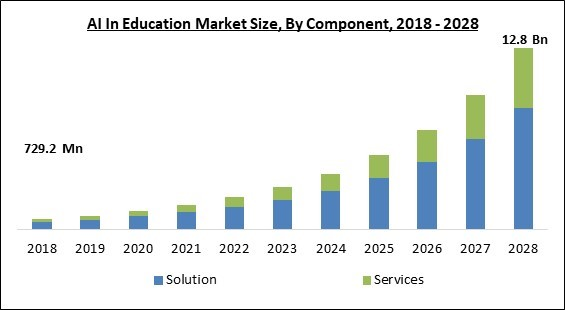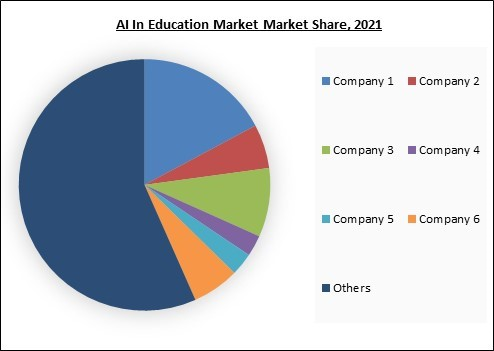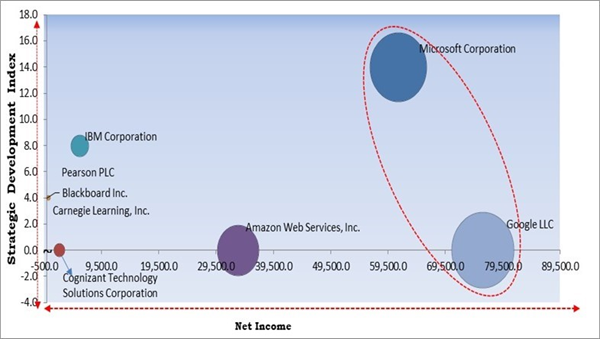The Global AI In Education Market size is expected to reach $12.8 billion by 2028, rising at a market growth of 33.5% CAGR during the forecast period.
Giving teachers, students, and educators a better experience is part of the application of AI in education. Numerous service providers are developing unique AI education solutions or services that connect to numerous education platforms. The demand for AI in education is also rising as online learning is becoming a more popular choice for skill development. As there is a growth in AI-backed business applications, tech corporations cooperated with colleges to introduce new training formats for AI talent in order to better fit with the development trends and latest industry developments.
Giving teachers, students, and educators a better experience is part of the application of AI in education. Numerous service providers are developing unique AI education solutions or services that connect to numerous education platforms. The demand for AI in education is also rising as online learning is becoming a more popular choice for skill development. As there is a growth in AI-backed business applications, tech corporations cooperated with colleges to introduce new training formats for AI talent in order to better fit with the development trends and latest industry developments.
Artificial intelligence has the ability to address some of the most significant issues facing education nowadays, such as innovative teaching and learning methods, and eventually quicken the realization of SDG 4. However, these quick technological advancements necessarily carry with them a number of risks and difficulties that have thus far surpassed regulatory structures and policy discussions. Enhanced education experience can be achieved with the help of AI technologies, and UNESCO is committed to assisting Member States in doing so while ensuring that the use of AI in educational settings is governed by the fundamental values of equity and inclusion.
The leading players in the market are competing with diverse innovative offerings to remain competitive in the market. The below illustration shows the percentage of revenue shared by some of the leading companies in the market. The leading players of the market are adopting various strategies in order to cater demand coming from the different industries. The key developmental strategies in the market are Acquisitions, and Partnerships & Collaborations.
The major strategies followed by the market participants are Partnerships. Based on the Analysis presented in the Cardinal matrix; Microsoft Corporation and Google LLC are the forerunners in the AI In Education Market. Companies such as Amazon Web Services, Inc., IBM Corporation and Pearson PLC are some of the key innovators in AI In Education Market.
The market research report covers the analysis of key stake holders of the market. Key companies profiled in the report include IBM Corporation, Microsoft Corporation, Google LLC, Cognizant Technology Solutions Corporation, Pearson PLC, Amazon Web Services, Inc., Carnegie Learning, Inc., Blackboard, Inc., BridgeU Limited, and DreamBox Learning, Inc.
Giving teachers, students, and educators a better experience is part of the application of AI in education. Numerous service providers are developing unique AI education solutions or services that connect to numerous education platforms. The demand for AI in education is also rising as online learning is becoming a more popular choice for skill development. As there is a growth in AI-backed business applications, tech corporations cooperated with colleges to introduce new training formats for AI talent in order to better fit with the development trends and latest industry developments.
Giving teachers, students, and educators a better experience is part of the application of AI in education. Numerous service providers are developing unique AI education solutions or services that connect to numerous education platforms. The demand for AI in education is also rising as online learning is becoming a more popular choice for skill development. As there is a growth in AI-backed business applications, tech corporations cooperated with colleges to introduce new training formats for AI talent in order to better fit with the development trends and latest industry developments.
Artificial intelligence has the ability to address some of the most significant issues facing education nowadays, such as innovative teaching and learning methods, and eventually quicken the realization of SDG 4. However, these quick technological advancements necessarily carry with them a number of risks and difficulties that have thus far surpassed regulatory structures and policy discussions. Enhanced education experience can be achieved with the help of AI technologies, and UNESCO is committed to assisting Member States in doing so while ensuring that the use of AI in educational settings is governed by the fundamental values of equity and inclusion.
COVID-19 Impact Analysis
The COVID-19 pandemic delivered a significant impact on the worldwide economy. Various businesses all over the world were majorly affected due to the pandemic. In addition, the advent of the pandemic also significantly disrupted the education infrastructure all over the world. Various industries were severely affected by the COVID-19 outbreak. The COVID-19 pandemic had a detrimental effect on the education sector. Schools colleges and other educational institutes all over the world were shut down, due to which, there was a drop in the demand for AI learning in in-person education.The leading players in the market are competing with diverse innovative offerings to remain competitive in the market. The below illustration shows the percentage of revenue shared by some of the leading companies in the market. The leading players of the market are adopting various strategies in order to cater demand coming from the different industries. The key developmental strategies in the market are Acquisitions, and Partnerships & Collaborations.
Market Growth Factors
Enhanced Student And Teacher Experience
One of the key factors that are driving the growth of the AI in education market is the fact that it significantly improves the learning and teaching experience. Vendors of AI technology are creating electronic gadgets with AI capabilities by creating sophisticated learning systems that enhance learning procedures. For educational institutions to survive in a world with cutthroat competition, they must provide the finest learning environment. For instance, Century Intelligent Learning created a classroom employing AI technology that allows teachers to create academic curricula online, allowing students to access their curricula whenever they choose.Saves A Lot Of Time And Cost
The administrative team works continuously for hours, whether it be filing paperwork, sending texts and emails, getting in touch with students or their parents, or producing periodic reports. In a similar manner, professors and teachers must grade papers for tests and homework, plan lesson plans, prepare for upcoming classes, etc. It consumes a significant amount of time for these educators. The remaining time is set aside for marking test papers, creating lesson plans for future classes, and finishing up administrative tasks. The artificial intelligence expert can assist teachers in developing an AI system that is expected to increase staff and student productivity.Marketing Restraining Factor:
Slow Digitalization Due To The Digital Divide
The diffusion of digitalization in LMIC, or low- and middle-income countries, is very slow. This is attributed to the prevalence of the digital divide all over the world. The digital divide can be defined as the reduced digital growth of developing and underdeveloped countries in contrast to developed countries due to the lower penetration of technologies. There is a significant number of LMICs that are struggling to bring technological advancements. AI-enabled deployments are completely reliant on accessible data, IT infrastructures, and Internet of Things devices for gathering instances to produce correct results due to the absence of funding for the fundamental requirements of IT infrastructures within poor nations.Component Outlook
Based on component, the AI in education market is classified into solutions and services. In 2021, the services segment registered a significant revenue share of the AI in the education market. The growth of the segment is increasing due to the rise in online education brought on by the pandemic. Additionally, the market is being driven by rising government and private sector investments in AI education for the improvement of the educational system. Venture capitalists (VCs) invested significant amounts in AI businesses in 2020.Deployment Mode Outlook
On the basis of deployment, the AI in education market is bifurcated into Cloud and On-premises. In 2021, the cloud segment procured the highest revenue share of the AI in the education market. Reduced ownership costs along with a growing demand for educational data sharing among international campuses are two reasons that have contributed to the expansion of the cloud segment. Additionally, it enables academic institutions to integrate cutting-edge AI technology into their current operating model without having to increase their capital expenditures.Technology Outlook
By technology, the AI in education market is segmented into Natural Language Processing (NLP) and Machine Learning. In 2021, the natural language processing segment registered a significant revenue share of the AI in the education market. The bolstering growth of the segment is owing to an increase in the demand for virtual learning among colleges and universities. Investments from educational facilities are increasing in technological advancements in order to offer the best-in-class learning experience to their students. In addition, it is expected to also streamline several teaching processes for teachers.Application Outlook
Based on application, the AI in education market is fragmented into Learning Platform & Virtual Facilitators, Intelligent Tutoring System (ITS), Smart content, Fraud and Risk Management and Others. In 2021, the learning platform and virtual facilitators segment acquired the biggest revenue share of the Ai in the education market. The growth of this segment is owing to the expansion of digital education learning technology. Additionally, employing a variety of abilities and advice relevant to social growth, virtual facilitators assist students in resolving challenging real-time social issues.End-Use Outlook
On the basis of end-use, the AI in education market is categorized into K-12 Education, Higher Education and Corporate Training & Learning. In 2021, the Corporate Training & Learning segment held a significant revenue share of the AI in the education market. Some of the major factors driving businesses to make the most of their resources are the rapidly shifting market conditions and growing market competition. Therefore, in order to stay up with the constantly shifting market expectations, firms must promptly train their staff members and keep them informed of the latest developments.Regional Outlook
Region-wise, the AI in education market is analyzed across North America, Europe, Asia Pacific and LAMEA. In 2021, North America procured the maximum revenue share of the AI in the education market. The market in the region is being driven by elements including the presence of top organizations that create technology infrastructure facilities, solutions, and services, and the massive number of end-users utilizing educational gadgets for AI in education. For instance, the IBM corporation announced that it is expected to train people in new skills through partnerships with business and academia.Cardinal Matrix - AI In Education Market Competition Analysis
The major strategies followed by the market participants are Partnerships. Based on the Analysis presented in the Cardinal matrix; Microsoft Corporation and Google LLC are the forerunners in the AI In Education Market. Companies such as Amazon Web Services, Inc., IBM Corporation and Pearson PLC are some of the key innovators in AI In Education Market.
The market research report covers the analysis of key stake holders of the market. Key companies profiled in the report include IBM Corporation, Microsoft Corporation, Google LLC, Cognizant Technology Solutions Corporation, Pearson PLC, Amazon Web Services, Inc., Carnegie Learning, Inc., Blackboard, Inc., BridgeU Limited, and DreamBox Learning, Inc.
Strategies deployed in AI In Education Market
» Partnerships, Collaborations and Agreements:
- May-2022: Microsoft collaborated with ITE, an education institution. following this collaboration, the companies is expected to integrate an AI lab in ITE College East to work as an innovation center in order to launch AI concepts, applications, and skills across industries for ITE students. Moreover, the companies is expected to also expand the exposure of AI principles and offer skilling opportunities to more than 4,000 students.
- Feb-2022: IBM came into a collaboration with the University of Florida, a public land-grant research university. This collaboration aimed to launch a public land-grant research university in order to extend UF’s strategy to become an international leader in AI, fintech, data science, and other associated technologies, which can help in solving major challenges in the society.
- Feb-2022: IBM entered into an agreement with IE University, a private university. This agreement aimed to accelerate the strategy to make Madrid a key Artificial Intelligence ecosystem across Europe via the development of Pier 17. in addition, IBM's experts is expected to join IE's adjunct faculty to aid in the identification of professors for the Educating AI innovators as well as Tech-makers program.
- May-2021: Microsoft entered into an agreement with the Ministry of Tribal Affairs, a branch of the Government of India. Under this agreement, the entities is expected to develop an AI curriculum for tribal students in Hindi and English at the Eklavya Model Residential Schools as well as Ashram Schools in the country.
- Nov-2020: Microsoft signed an MoU with the Education University of Hong Kong, a publicly funded tertiary institution. With this agreement, the entities is expected to focus on the integration of Artificial Intelligence into its Bachelor of Education programs curriculum.
- Oct-2020: Microsoft came into a partnership with the All India Council For Technical Education, a statutory body to empower learners and educators. Under this partnership, Microsoft is expected to offer more than 1500 courses to educators and students via AICTE's e-learning portal ELIS. for no cost.
- Jun-2020: IBM joined hands with the Central Board of Secondary Education, an Indian national board of education. This collaboration aimed to add a curriculum with the purpose of integrating artificial intelligence in the education of classes XI and XII. Moreover, this collaboration is expected to also complement CBSE's SEWA, or Social Empowerment through Work Education and Action, program.
- Mar-2020: Pearson came into a partnership with MindBridge, a leader in financial risk discovery. This partnership aimed to integrate artificial intelligence into academic institutions.
- Feb-2020: Pearson teamed up with the UCL Institute of Education, an education school of University College London. Through this collaboration, the companies is expected to focus on the end-to-end experience of test-takers in taking PTE for study or migration purposes.
» Acquisitions and Mergers:
- Sep-2021: Blackboard announced a merger with Anthology, a leading provider of higher education solutions. This merger aimed to develop a comprehensive as well as modern EdTech ecosystem across the world. In addition, it is expected to expedite the transformation at education institutions to improve earner experience and propel institution and student success.
- Sep-2020: Carnegie Learning acquired Scientific Learning, a leader in brain-based learning technology and research. With this partnership, the company aimed to strengthen the education technology offerings of both companies in order to drive a mutual vision to improve student learning outcomes via leading-edge technology developed through rigorous research.
Scope of the Study
Market Segments Covered in the Report:
By Component
- Solution
- Services
By Application
- Learning Platform & Virtual Facilitators
- Intelligent Tutoring System (ITS)
- Smart content
- Fraud & Risk Management
- Others
By End Use
- Higher Education
- Corporate Training & Learning
- K-12 Education
By Deployment Mode
- Cloud
- On-premise
By Technology
- Machine Learning
- Natural Language Processing (NLP)
By Geography
- North America
- US
- Canada
- Mexico
- Rest of North America
- Europe
- Germany
- UK
- France
- Russia
- Spain
- Italy
- Rest of Europe
- Asia Pacific
- China
- Japan
- India
- South Korea
- Singapore
- Malaysia
- Rest of Asia Pacific
- LAMEA
- Brazil
- Argentina
- UAE
- Saudi Arabia
- South Africa
- Nigeria
- Rest of LAMEA
Key Market Players
List of Companies Profiled in the Report:
- IBM Corporation
- Microsoft Corporation
- Google LLC
- Cognizant Technology Solutions Corporation
- Pearson PLC
- Amazon Web Services, Inc.
- Carnegie Learning, Inc.
- Blackboard, Inc.
- BridgeU Limited
- DreamBox Learning, Inc.
Unique Offerings from the Publisher
- Exhaustive coverage
- The highest number of market tables and figures
- Subscription-based model available
- Guaranteed best price
- Assured post sales research support with 10% customization free
Table of Contents
Chapter 1. Market Scope & Methodology
Chapter 2. Market Overview
Chapter 3. Competition Analysis - Global
Chapter 4. Global AI In Education Market by Component
Chapter 5. Global AI In Education Market by Application
Chapter 6. Global AI In Education Market by End-use
Chapter 7. Global AI In Education Market by Deployment Mode
Chapter 8. Global AI In Education Market by Technology
Chapter 9. Global AI In Education Market by Region
Chapter 10. Company Profiles
Companies Mentioned
- IBM Corporation
- Microsoft Corporation
- Google LLC
- Cognizant Technology Solutions Corporation
- Pearson PLC
- Amazon Web Services, Inc.
- Carnegie Learning, Inc.
- Blackboard, Inc.
- BridgeU Limited
- DreamBox Learning, Inc.
Methodology

LOADING...












